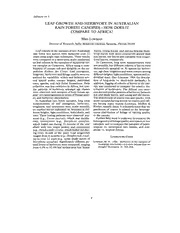
LEAF GROWTH AND HERBIVORY IN AUSTRALIAN RAIN FOREST CANOPIES-HOW DOES IT COMPARE TO AFRICA? PDF
Preview LEAF GROWTH AND HERBIVORY IN AUSTRALIAN RAIN FOREST CANOPIES-HOW DOES IT COMPARE TO AFRICA?
Selbyana 14: 9 LEAF GROWTH AND HERBIVORY IN AUSTRALIAN RAIN FOREST CANOPIES-HOW DOES IT COMPARE TO AFRICA? MEOLowMAN Director of Research, Selby Botanical Gardens, Sarasota, Florida 34239 Leaf cohorts in the canopies of five Australian leaves, young leaves, and species bearing short rain forest tree species were measured over 12 lived leaves were more extensively grazed than years using single rope techniques. These results sun leaves, old leaves and canopies with longer were compared to a short-term study conducted lived leaves, respectively. on leaf cohorts in the canopies of equatorial for In Cameroon, long term measurements were est canopies in Cameroon, Africa using a com not possible, but different cohorts ofleaves were bination of canopy raft and dirigible on the ex destructively sampled on 30 species for herbiv pedition Radeau des Gimes. Leaf emergence, ory, age class, toughness and water content among longevity, herbivory and foliage quality were ex different heights, light conditions, species and in amined for variability within and between sev dividual trees. (See Lowman 1984 for descrip eral spatial scales: canopy heights, individual tion of long-term vs. short-term methods.) In trees, species, and rain forest formations. Data addition, fogging of cohorts ofleaves in the can collection was less extensive in Africa, but sim opy was conducted to compare the relative dis ilar patterns of herbivory amongst age classes tribution of herbivores. The African tree cano were observed, and canopies of both forests ap pies showed similar patterns ofh erbivory between pear very heterogeneous in terms of foliage qual sun and shade leaves, and young and old leaves. ity and herbivory distribution. The distribution of insects was also patchy, with In Australian rain forest canopies, long term some canopies having almost no insects and oth measurements of leaf emergence, herbivory, ers having many insects (Lowman, Moffett & toughness, and senescence were made monthly Rinker, unpubl. data). It is hypothesized that the on marked leaves replicated on branches at dif patchiness of insects is related to the heteroge ferent heights, light conditions, individuals, and neous distribution of foliage of varying quality sites. Three leafing patterns were observed: sea in the canopy. sonal (e.g., Toona australis, which was decidu Further field work is underway to examine the ous), intermittent (e.g., Doryphora sassafras, heterogeneity offoliage quality and insects in tree which leafed out during 10 months of the year canopies, and to compare the canopies of paleo albeit with two major peaks), and continuous tropical vs. neotropical rain forests, and tem (e.g., Dendrocnide excelsa, which leafed out dur perate vs. tropical forests. ing every month of the year). Leaf longevities ranged from 6 months (e.g., Dendrocnide excel LITERATURE CITED sa) to over 12 years (e.g., some shade leaves of Doryphora sassafras). Significantly different an LoWMAN, M. D. 1984. Herbivory in the canopies of nuallevels of herbivory were measured, ranging Australian rain forests-is it more intense than we from 4.5% to 32.5% leaf surface area lost. Shade thought? Biotropica 16: 264-268. 9
